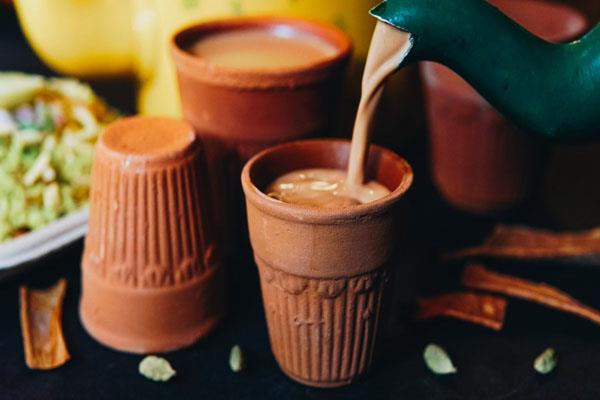In a bid to reduce plastic waste in India, Railway Minister Piyush Goyal recently announced that tea stalls on railway stations will replace plastic cups with Indian kulhads.
Raise your hand, if you also believe that Indians really get excited about simple things and so they do always get excited for ‘kulhad chai’. Tea for Indians is like a blessing, they live on it. This traditional drink has been such an integral part of Indian households that the talk of kulhad chai is nothing new for the general populace. Recently, in the government’s bid to save mother earth from the excessive use of plastic, Railway Minister Piyush Goyal announced that tea stalls on railway stations across India will replace plastic cups with Indian kulhads.
Yes! you heard that right. Now whenever you are going to travel with Indian railways, you’ll receive your cup of tea in a traditional clay cup, popularly known as kulhad. You can now have your tea on the railway stations with the earthy essence that you love.
Kulhads has been elbowed out by the most utilitarian plastic and paper cups over the past few decades at the railway stations in India. These clay cups introduced by former railway minister Lalu Prasad 15 years ago in the Indian Railways are all set to make a comeback at the catering units now. In 2004, Lalu Prasad issued an order to start serving hot beverages in kulhads to boost potter’s income and switch to a ‘greener’ alternative.
In a significant move towards plastic-free India, Railway Minister Piyush Goyal said, “Tea will now be sold in environment-friendly ‘Kulhads’ (earthen cups) in place of plastic cups at all railway stations across India.” He also said that this initiative will help Indian railways to contribute towards a plastic-free India.
As per the reports, the Varanasi and Rae Bareli railway stations are already using terracotta products for catering. Also, nearly 400 railway stations in the country serve tea in kulhads, but with the recent announcement, the government is trying to make sure that all the railway stations in India serve tea only in kulhads.
The kulhad wala India:
Honestly, nobody can pin-point when and where the tradition of serving kulhad chai began in the Indian sub-continent. These simple yet attractive earthen pots have always been around humans since the Indus Valley Civilisation, as per archaeological findings. That was 5000 years ago!
A kulhad is a plain traditional clay cup, without any handles. It is unpainted, unadorned and simple in design. Like all earthenware, these clay cups tend to soak up a bit of the hot fluids poured into it. So, when hot tea is poured into a kulhad, a bit of the tea soaks into the clay, intermingling two different flavours. This lets the drinker have an earthy flavour.
Piping hot tea served in kulhad is every Indian’s favourite. Kulhad can make for the best companion while waiting for trains at the platforms, and now with the recent decision of the Central government of using kulhads at the railway stations across India, the government apart from giving an authentic taste to the passengers is also trying to save our environment.
The other benefits:
The major reason behind the government’s recent move is to ensure the decreased use of plastics in the country. It is very obvious that the use of kulhads in place of plastic tea cups will give passengers a refreshing feel. But it is important to look at the fact that apart from reducing the plastic consumption of the country the government is also trying to provide a huge market to the local potters who are struggling to make a survival today.
This decision of using kulhad in the Indian Railways will also provide employment opportunities to the local potters of the country. This announcement by the Indian government is a win-win situation for all. The restriction on the use of plastic tea cups will ensure a step ahead in the free-plastic India initiative, while simultaneously it will also help the local craftsmen of the country.
Kulhads aren’t exactly eco-friendly:
It’s since last year, the Indian government is trying to adapt the use of kulhads at the railway stations in order to phase out the use of single-use plastics. Kulhads are always termed to be eco-friendly and biodegradable but according to various reports and years of scientific dialogue on environmental policies, it is believed that biodegradability is not the only parameter to gauge whether an item is eco-friendly or not.
There are many different situations and criteria that have to be taken into account to understand whether using kulhads will help us protect our environment. After thermal power plants and the iron & steel industry, brick kilns are the largest users of coal in India. Terracotta items (clay-based) are also baked in such furnaces. While these products are in the process of making, they release immense amount of carbon emissions that is also harmful for the environment.
Also, it should be noted that organic matter stored in clay, when burnt, returns sequestered carbon back into the air. Carbon footprint is not the only environmental impact of kulhads. The type of soil used to create earthenware also happens to be among the most fertile types of soil, ultimately degrading the quality of soil because during the process of baking, the organic carbon content of the soil, gets removed. So, when terracotta ultimately ends up in the soil, the overall quality of the soil is degraded.

